Matador Network's Blog, page 533
February 4, 2022
Working holiday visa for Australia

If you are between the ages of 18 and 30 and would love to spend a year or two in Australia, the Work and Holiday or Working Holiday visa Australia is for you! You can legally work anywhere in the country, and it’s easy to apply for. Read these steps carefully, and you could be on your way earlier than you think; 90 percent of applications are processed in less than two months.
How to get a Working Holiday Visa Australia or Work Holiday Visa:
1. Figure out which visa you’re eligible for2. Start getting your documents together
3. Apply
4. Wait
5. When you get your visa, rejoice
6. Applying for second 462 or 417 visas1. Figure out which visa you’re eligible for
There are two kinds of visas that allow you to live and work in Australia temporarily: the 417 (Working Holiday) and the 462 (Work and Holiday).
Working Holiday (subclass 417) visas are open to people with passports from Belgium, Canada, Cyprus, Denmark, Estonia, Finland, France, Germany, Hong Kong, Republic of Ireland, Italy, Japan, Republic of Korea, Malta, Netherlands, Norway, Sweden, Taiwan, and the United Kingdom.Work and Holiday (subclass 462) visas are open to people with passports from Argentina, Bangladesh, Chile, Indonesia, Malaysia, Poland, Thailand, Turkey, the United States, and Uruguay.There are a few differences between the visas. If you have more than one passport for countries that make you eligible for EITHER visa, you can choose to apply based on which one you prefer.
462 visas have education requirements — for most of the listed countries, this means you need to have completed at least two years of a tertiary education degree. A community college or any university degree would count towards this requirement.462 visa applicants MUST provide police certificates from each country they have lived in for more than 12 months, as character references. 417 visa applicants MAY have to provide these certificates, but the application clearly states that they are not needed unless requested.462 visa applicants MUST prove language competence, which the application form terms “functional English”. This could be proved either through having a passport from a country for whom English is a first language, taking a competency test, or otherwise showing competency (through an oral exam, for example).462 visa applicants MUST provide a letter of support from their home government UNLESS you are from the People’s Republic of China, Singapore, or the United States. Malaysians may provide a Malaysian Certificate of Good Conduct.For both visas, you may not hold one job for more than 6 months in a row. The visa is designed for you to be on holiday in Australia, and still be able to work occasionally (to further fund your holiday); Australian immigration feels that if you want to work more than 6 months, you should apply for a work visa instead.
Both visas have the possibility of applying for a second visa, or an extension, which will be discussed later in this article.
2. Start getting your documents togetherNeither visa will ask for original documents right off the bat; certified copies are better. You can find the exact list for the 417 visa here and the 462 visa here. You will need:
A copy of the photo page of your current passport, which should also include your birthdate, the issue date and location of your passport, and your signature.A certified copy of your birth certificate showing both your parents’ names. If you don’t have a birth certificate, you can provide any other official document that proves your identity (like a government-issued ID).Two passport-sized photos, with your name printed on the back.Evidence of sufficient funds to support your holiday travel: at least $5000 AUD. This could be a bank statement or a certified letter from your bank.If you served in the armed forces of any country, you must provide discharge papers.If your name has changed, evidence of the name change.The fee for the application. Fees change, so it is a good idea to check the website for exact costs.Further documents required for your 462 visa:
Evidence of relevant educational qualifications.For relevant countries, a valid letter of government support for this application.Evidence that you have a level of English which is assessed as at least functional.Police certificates from any country lived in for more than 12 months.3. ApplyOnce you have all your documents together, and you’ve saved up to pay your fees, it’s time to actually apply.
462 Visa: If you are from the USA, you can apply for your 462 visa online. Otherwise, or if you are a US citizen who can’t apply online for some reason, you can send or hand-deliver your application to the Australian Visa Application Office in your home country. This only applies if it is your first Work and Holiday Visa — see below for more info on applying for your second.417 Visa: All applicants can apply online, as long as you make an “ImmiAccount”. If you cannot apply online, you can bring your paperwork and documentation to an Australian Immigration Office.4. WaitSometimes, you may be asked to complete medical or health checks — Australia is proudly tuberculosis and rabies-free, and many applicants are asked to provide evidence of recent medical check-ups or chest X-rays (to prove they don’t have TB). I did not have to do this, but many non-Australians who applied for my same university did, so your mileage may vary. If you are asked for more documents, it will appear on your ImmiAccount.
462 Visa: 75 percent of applications are processed within 24 days and 90 percent are processed within 56 days.417 Visa: 75 percent of applications are processed in 16 days, and 90 percent are processed in 32 days.If your circumstances change, any of the information on your application changes, or you need to withdraw your application, you must notify the Australian Immigration service immediately. This is especially relevant if your passport expires during the time between when you lodge the application and when you might arrive in Australia. Make sure your passport has at least a year or two of validity on it when you apply. If you have less than 6 months before it expires, get a new passport before you apply — you don’t want to get held up in the airport or denied entry because of a bureaucratic problem.
5. When you get your visa, rejoiceAssuming you followed all the rules and got all the paperwork they asked for, you will be issued a digital visa. You will not get a physical form that goes in your passport (sadly, if you like this sort of souvenir — I love flipping back over my old stamps and visas). Your visa is associated with your passport or your ImmiCard, and it also has a unique ID number that you can use to access it when necessary.
6. Applying for second 462 or 417 visasLet’s say you’re having such a good holiday in Australia that you’d like to stay for another year! Well…you can. It might even be easier to apply for, provided you fulfill the requirements. What are the requirements? So glad you asked.
You must have completed all the requirements for the first 417 or 462 visa.You must not have held more than one 417 or 462 visa (you can’t have THREE visas).If you have a 417, you cannot have had a 462; and vice versa. This is to stop people with multiple citizenships from applying for TWO visas under each passport.You must not have turned 31 by the time you apply. You must have completed THREE MONTHS of specified work in regional Australia during the term of your first visa.What is specified work, in regional Australia? This guideline was developed to help industries in remote areas with high turnover get more workers. These are acceptable fields:
plant and animal cultivationfishing and pearlingtree farming and fellingFor 462 visa applicants: tourism and hospitalityFor 417 visa applicants: mining, constructionThe job you fulfill must be eligible, which usually means labor-intensive. Working as a bookkeeper in one of these fields, for example, does not count towards your three-month requirement. Neither is working as a nanny on a farm, a wine taster for a vineyard, or cleaning buildings belonging to a construction office. The work must be paid.
Regional Australia usually means outside of the major cities. Canberra, or anywhere in the Australian Capital Territory, cannot be counted as regional.
There are a lot of guidelines about how to calculate your hours worked, and whether or not weekends count, and what happens if a cyclone disrupts your harvesting season. You can find all of the information for 417 visas here and for 462 visas here. If this is what you are interested in doing, I suggest you read it extremely carefully to ensure that you can fulfill the guidelines. If you are already in Australia and applying for a second 417 or 462 visa, you must apply for it before your current visa runs out.
Up until very recently, 462 visas were not eligible for a second application/extension. This changed in February of 2017. If you find articles dating before that in doing further research, they will state that you cannot get a second 462 visa: this information is incorrect. 
A version of this article was previously published on December 8, 2017, and was updated on February 4, 2022.
More like thisTrip PlanningWhich is the better country for a working holiday: Australia or New Zealand?February 3, 2022
Happy birthday, Yellowstone: see how the park has changed in 150 years

On March 1, 2022, Yellowstone National Park will celebrate its 150th anniversary. President Ulysses S. Grant passed the Yellowstone National Park Protection Act in 1872, establishing America’s very first national park for the “benefit and enjoyment of the people.”
A lot has changed in Yellowstone history the century and a half since it became a park. President Herbert Hoover adjusted the park’s boundaries in 1929 and 1932, expanding it by more than 7,000 acres. Visitor numbers have skyrocketed, ballooning from roughly 1,000 people in Yellowstone’s early days to as many as four million annual visitors today. The development of park infrastructure and amenities, such as the roads built by the US Army Corps of Engineers in 1883 — and the overnight accommodations that soon followed — laid the groundwork for heavy visitation by making the park more accessible.
Today, the area’s Indigenous heritage is part of the Yellowstone history, after being all but erased by early park officials. American Indian tribes including the Shoshone, Nez Perce, Coeur d’Alene, Kiowa, Blackfeet, and Cayuse used the land as a seasonal hunting and gathering ground for roughly 11,000 years before they were driven out by the American government. At least one tribe — the Tukudika — lived there year-round.
Yet much has also remained the same thanks to Yellowstone’s federal protections. Though unpredictable in nature, iconic thermal features such as Old Faithful and Grand Prismatic Spring continue to draw visitors from across the US and around the world. Wildlife populations have fluctuated over time but continue to represent the region’s native fauna. Even the earliest structures dating to early Yellowstone history remain largely intact and, on the face, unchanged.
In honor of Yellowstone’s big birthday, check out these epic before and after shots for a closer look at America’s first national park in its inaugural days versus now.

Photo: National Park Service + cb_travel/Shutterstock
Yellowstone’s first groundskeeper, Harry Yount, was appointed on June 21, 1880. Yount was posthumously recognized as a park ranger, making him the first official national park ranger in the United States. Pictured above are a group of female park employees sitting on the rim of Yellowstone’s Grand Canyon in 1904 and a shot of the canyon today.

Photo: National Park Service + Microfile.org/Shutterstock
Yellowstone’s early history is rife with threats to its protected status. To fend off developers, poachers, and souvenir collectors, the United States Army was stationed in the park for more than 30 years. Construction on Fort Yellowstone at Mammoth Hot Springs was completed in 1891. Today, the site houses the park’s Albright Visitor Center, pictured above.

Photo: National Park Service + Maciej Bledowski/Shutterstock
Pictured above is the park’s Fishing Bridge spanning the Yellowstone River, originally built in 1902. The bridge visitors walk across today was constructed in 1937. Though it was once a popular spot for visitors to cast a line, angling has not been permitted on Fishing Bridge since 1973. In terms of Yellowstone history, it’s one of the coolest still-standing structures in the park.

Photo: National Park Service + YegoroV/Shutterstock
Yellowstone plays host to the largest bison population on American public land and it’s a population that’s still growing. Gray wolves are another significant species found in the park. Though the gray wolf population had nearly disappeared by the mid-1900s, the species was reintroduced in 1995, and an estimated 94 wolves call Yellowstone home today.

Photo: National Park Service + Jeffrey B. Ross/Shutterstock
On April 24, 1903, President Theodore Roosevelt laid the cornerstone for the Roosevelt Arch, marking Yellowstone’s northern entrance. Of the park’s five gateways, only the northern entrance is open year-round.

Photo: National Park Service + f11photo /Shutterstock
A year later, in 1904, construction on the Old Faithful Inn was completed. A marvel of what’s been coined “parkitecture,” the inn was designated a National Historic Landmark in 1987 and remains one of the largest log-style structures in the world. Guests are still welcome and it’s one of the oldest buildings not just in Yellowstone history, but in the entire history of the national parks.

Photo: National Park Service + Paul Bryan/Shutterstock
Pictured above are park visitors wading in the Great Fountain near Yellowstone’s Lower Geyser Basin in 1908. Note that swimming is not permitted in any of the park’s thermal features today.

Photo: National Park Service + Elizabeth C. Zurek/Shutterstock
Between 1883 and 1917, the Wylie Permanent Camping Company operated the park’s most coveted campgrounds. Yellowstone now has 12 developed campgrounds with over 2,000 total campsites, as well as designated backcountry campsites for permit holders.

Photo: National Park Service + Pung/Shutterstock
Above, park visitors enjoy views of the Mammoth Hot Springs from the complex’s terraces (date unknown). The Mammoth Terraces include roughly 50 hot springs next to Fort Yellowstone. It’s one of the park’s most popular attractions.

Photo: National Park Service + f11photo/Shutterstock
Yellowstone’s most famous landmark, Old Faithful, has been erupting semi-regularly for at least as long as the park has existed, putting on roughly 20 shows per day. The geyser typically shoots water between 100 and 180 feet high, but it’s not the park’s tallest. That title belongs to Steamboat Geyser in the Norris Geyser Basin. It’s eruptions reach heights of over 300 feet, making it the tallest active geyser in the world. 
From pickled to braised, a guide to the best chicken feet dishes from China

Americans who have encountered chicken feetat dim sum restaurants probably already know that the dish is popular in China. Some stories claim that people originally began eating it in order to save every part of the slaughtered animal before the age of industrial farming. This is not completely true. The earliest record of chicken feet as food is in a chronicle compiled in the 3rd century BC. “When the duke eats chicken, he must eat the feet, and wouldn’t be satiated until he has eaten thousands of them,” the author wrote. This might be an exaggeration, but reducing food waste probably wasn’t on the duke’s mind.
Having grown up in China, I have always known chicken feet as a homey dish. Like wings and livers, they are sold by weight in farmers’ markets and labeled as “chicken accessories.” My dad cooks them the same way as he does other meat ‒ blanch them to get rid of excess fat, and braise them until the tendons become pliable and the bone tissues grisly. For seasoning, he doesn’t follow a specific formula but uses common sense instead ‒ a ladle of light soy sauce for umami, half a ladle of dark soy sauce for to add color, a few slices of ginger, a handful of star anises, and occasionally a pinch of red chili pepper. The tendons are extra soft and rich when fresh off the stove. But I also love braised chicken feet as a leftover, when the collagen-rich sauce gels into bouncy chicken jelly, which I sometimes scoop out of the bowl and eat plain.
The most popular varieties of chicken feet have their origins in Sichuan and Cantonese cuisines. The former is known for its spiciness; the latter emphasizes working with the ingredient’s original flavors. A Sichuanese appetizer called zhangzhongbao (掌中宝, loosely translated as treasure in the palm) is made completely of footpads, the fleshy knots in the center of the birds’ feet. Each serving consists of a small mound of the footpads, deep fried and tossed in chili oil. In Cantonese-style dim sum restaurants, this dish is fried before they are steamed with fermented soy beans, so that the sauce clings to the wrinkled skins more easily. Sometimes the bones, including those on the chicken fingers, are removed before cooking.
These days, shoppers can find ready-to-eat chicken feet snacks in almost any grocery store in China. A dish called Paojiao fengzhua (泡椒凤爪, loosely translated as marinated chili pepper and chicken feet) elevated chicken feet to its current popularity. Essentially a crunchy, tangy, and fiercely spicy pickle, it’s made by marinating whole chili peppers and boiled chicken feet in an acidic brine.
These days, social media also plays a part in the spread of new recipes. Ideas that go viral on Tiktok (known as Douyin in China) are quickly picked up by food companies, who in turn adapt them for mass manufacturing. A quick search for “chicken feet snack” on the online shopping site JD.com returns over 270,000 results. The selections are dazzling. Each flavor ‒ there are tens, if not hundreds, of them ‒ may come deboned or with bones, with or without fingers, in single servings or as part of gift baskets.
This doesn’t mean that chicken feet have lost their roots in the home kitchen. After all, this dish is best when fished out of the cooking pot before being served on the dinner table, or raided from the fridge when the jelly still clings to the fingers, or enjoyed with the most intimate friends when you can chew the bones and suck the sauce without a care about table manners. If you are ready to get messy, here are some classic chicken feet dishes that you can easily find in Asian grocery stores or in Chinese restaurants.
Marinated chili peppers and chicken feet (泡椒凤爪)
Photo: HelloRF Zcool/Shutterstock
Chicken feet are boiled, and then pickled in an acidic brine with a variety of herbs and spices including Sichuan peppercorns, star anise, and most importantly, whole chili peppers. For the brine, most recipes use rice vinegar or lemon juice, but traditionalists prefer to recycle the brine from previous batches for more complex flavors.
Chicken feet with lemon (柠檬凤爪)
Chicken feet are boiled and then marinated with sliced lemon and cilantro in diluted passion fruit juice. The recipe first went viral on TikTok (Douyin) during the pandemic lockdown, as a variation to the classic version with marinated chili peppers. Now, many food companies offer this flavor in vacuum packs.
Dim sum chicken feet (虎皮凤爪)

Photo: StrippedPixel.com/Shutterstock
You can find this version in almost any Cantonese-style dim sum restaurant. Chicken feet are fried and steamed with a sauce made from fermented beans and oyster sauce. In some recipes, the chicken feet are braised instead.
Sweet and sour chicken feet (白云凤爪)
A traditional Cantonese dish made by marinating boiled chicken feet in a juice made of sugar, vinegar, and rice wine. It is sweeter and milder than the Sichuanese version, and is served as a cold appetizer in many Cantonese restaurants.
Red-braised chicken feet (红烧凤爪)

Photo: joojoob27/Shutterstock
A classic stew that can be found in many homestyle restaurants. Chicken feet are blanched and then braised in a soy-based sauce. The use of seasoning is flexible, but some most commonly used spices are ginger, scallion, and five spice powder (made of star anises, cloves, cinnamon bark, Sichuan peppercorns, and fennel).
Soy-marinated chicken feet (卤凤爪)
In this dish, the sauce for the chicken feet is brought to a boil and let simmer for half an hour. Then the chicken feet are marinated in the sauce overnight to let the flavors seep in. It is often served as a cold appetizer in homestyle restaurants, and is also sold in vacuum packs.
“Treasure in the palm” (掌中宝)
A popular hot appetizer that can be found in many Sichuan restaurants. Chicken footpads are seasoned with salt and pepper and then fried. Many chefs finish by tossing them in chili oil but non-spicy versions are not hard to find.
7 cold-weather spring break destinations that are even better than the beach

“Spring Break Iceland!” isn’t exactly a T-shirt you’d expect to return from vacation with. Spring breakers tend to favor warm climates in places like Daytona Beach, Florida or Cabo and Cancun, Mexico. But don’t follow the masses and limit yourself to warm-weather destinations. Instead, venture into colder climates to avoid the crowds, spend less money, and take in all the beauty and fun winter weather lends. Whether you’re a college kid looking to blow off some steam during the mid-semester break, or a full-fledged adult planning a well-earned trip, these are the cold-weather destinations for a great Spring Break 2022.
1. Quebec City, Canada
Photo: Vlad G/Shutterstock
Just an eight-hour drive from New York City, Quebec City is a little taste of Europe in North America, with its historical buildings, narrow cobbled streets, and the impressive Château Frontenac towering over the St. Lawrence River. And, of course, Quebec City is particularly magical in the winter, when the river freezes and snow settles on the cobblestones.
Apart from simply enjoying the bistros, cafes, and independent shops along the snowy streets, you can check out the ice rink erected in the center of town every winter, or the ice toboggan in Old Quebec. Brave the toboggan, and you’ll find yourself flying past the Château Frontenac with views of the river. There’s also the Plains of Abraham, a historic park with areas for cross-country skiing, snowshoeing, and yes, more skating. If you’re a skier, try out the newly opened Club Med Quebec just 90 minutes away from Quebec City.
You can also embrace the brisk weather by stripping down and taking a dip in one of Spa Eastman’s huge outdoor hot tubs. Two hours south of the city, the spa is set on 350 acres of peaceful land, and perfect for those looking for a Spring bBeak 2022 defined by wellness rather than partying. If partying is your objective, however, look no further than the Grande Allée, a street in the heart of Old Quebec known for its nightlife.
2. Fairbanks, Alaska
Photo: youli zhao/Shutterstock
If you polled Americans for a power ranking of “the best US states for spring break,” Alaska would probably come in dead last. This dark horse, however, is actually one of the best spring destinations.
Fairbanks’ northerly latitude means spring is the perfect time to see the northern lights. Between August and April, the sky is darkest and the lights are on full display. It’s tough to predict exactly when the aurora will be visible, but the best way to view them is undoubtedly at Aurora Pointe — a small building atop a lonely hill, purpose-built for giving people a way to gather and see the lights. Just 20 minutes from town, Aurora Pointe is far enough from light pollution to give you a clear view of the sky. There’s also coffee, board games, and a warm communal atmosphere, all of which you’ll certainly need as you patiently wait for the lights to appear.
You can’t really visit Alaska during the snowy season without taking full advantage of the wintry fun. Rod’s Alaskan Guide Service in nearby North Pole offers dog sledding trips, snowmobile tours, and ice-fishing experiences. You can even combine them, setting out from Rod’s wooded cabin by snowmobile and stopping at a frozen lake to hunt for rainbow trout and arctic char.
Cap off your Alaska adventure by relaxing at Chena Hot Springs, a geothermal day spa perfectly-suited for the winter Alaska traveler. Here, you can take a dip in the outdoor or indoor hot tub, soak in the restorative waters of the geothermal Rock Lake, or treat yourself to a massage. There’s also an upscale restaurant on site that grows its own vegetables in a greenhouse just outside.
3. Monticello, New York
Photo: The YO1 Health Resort
If you want a Daytona Beach-style Spring Break 2022, complete with body shots and all nighters, Monticello, New York isn’t for you. If you’re looking for a more relaxing, wellness-oriented trip, however, this unassuming town in the Catskill Mountains is right up your alley.
The town might be home to just over 6,000 people, but it’s known for its huge spa sitting on over 1,300 acres of mountain land. The YO1 Health Resort offers customized, holistic treatment regimens, including head massages, Swedish massages, and acupuncture, designed to address a range of health concerns.
Apart from the spa, there are plenty of other ways to decompress in Monticello after a long winter. Thompson Town Park has several hiking and cross-country skiing trails, and the town is also home to a number of small lakes for fishing and canoeing. Kiamesha Lake, in particular, has two nature trails — Schiff and Peenpack — that are perfect for admiring the local flora, and even campsites for the truly adventurous.
4. Breckenridge, Colorado
Photo: Jacob Boomsma/Shutterstock
It doesn’t take much convincing to get a group together for a Colorado ski trip. Known for having some of the softest snow and most epic runs in the US, many of Colorado’s mountains are bucket-list destinations for skiers and snowboarders. Breckenridge, just over an hour southwest of Denver, is one of the most popular ski destinations in the state, and the spring conditions are arguably even better than winter.
Breckenridge has over 180 ski trails, the tallest chairlift in North America – the Imperial Express Superchair, climbing 12,840 feet. Breckenridge is more than just skiing, though. Whether you’re snowshoeing or hiking, there are hundreds of trails in the area, with the White River National Forest covering over two million acres. You don’t have to stray far from town to take advantage of it, either. The Carter Park Trail and Burro Trail can be accessed right at the base of Peak 9, right near the town center.
Because it wouldn’t be spring break without a healthy (or perhaps unhealthy) helping of alcohol, be sure to check out Breck’s apres ski scene – even if you’re not skiing. Breckenridge Brewery, the third oldest in the state, has been a town staple for decades. If you want something a little stronger, head down the street to the Breckenridge Distillery, which specializes in bourbon whiskey.
5. Mammoth Lakes, California
Photo: CreatingEzra/Shutterstock
Non-Californians often forget that it actually does snow in The Golden State. The town of Mammoth Lakes in Northern California, is home to Mammoth Mountain, a popular ski destination that often stays open through June. This means that unlike many other ski resorts, which may be in the midst of a crowd rush before closing their doors for the season, spring in Mammoth doesn’t mean vying for chairlifts with hordes of other people.
Apart from the mountain itself, you can go cross-country skiing and snowshoeing at the Tamarack Cross Country Ski Center. With a network of groomed Nordic trails past historic cabins and beautiful alpine lakes, this forested area is perfect for both families and groups of friends. The center also rents Nordic skis and snowshoes, and offers guided tours through the forest.
Fat biking is another popular Mammoth activity. Wave Rave Snowboard Shop rents them out to visitors, making it easy to visit both the town and surrounding forest trails — especially in the snow. One of the most popular routes extends from the Main Lodge to Minaret Summit, where you’ll get the best views of the area. Tamarack Lodge to Lake Mary is another scenic out-and-back route.
6. Iceland
Photo: Try-my-best/Shutterstock
Iceland is a country of extremes. Visit Iceland in winter, and you’ll get very little daylight, frigid temperatures, and highways that may be difficult to navigate. Visit in summer, and the sun hardly sets at all, and while the highways are in better shape, you’ll be sharing them with throngs of like-minded tourists. That’s what makes spring the perfect time to visit.
Everyone knows Iceland for its waterfalls, fjords, mountains, and lunar landscape, but what about its puffins? In spring, puffins migrate back to the coast of Iceland, primarily residing in the Westman Islands, Latrabjard cliff in the Westfjords, and on the south coast. Seeing a thriving puffin colony is one of the most memorable wildlife experiences you’ll ever have.
With road conditions more favorable than during the winter months, you should have no trouble renting a car and traveling the Ring Road — the highway that circles the country. The road brings you past some of Iceland’s natural wonders, including waterfalls, black-sand beaches, canyons, geysers, and natural hot springs. And since you beat the summer rush, you won’t have to elbow through a dozen others all trying to capture the exact same photo.
Iceland isn’t all outdoor adventure, either. The nightlife in the capital of Reykjavik will not leave you wishing you’d booked a trip to Cancun instead. Most of the city’s nightlife centers around Laugavegur, the city’s main shopping thoroughfare. The strip of bars here are largely free to enter, and with no lines, it’s the perfect city for bar-hopping.
7. Churchill, Canada
Photo: davidmarxphoto/Shutterstock
In Churchill, Canada, there are only three seasons: whale watching season, polar bear season, and aurora season. Spring is aurora season, and it’s Churchill’s most underrated. This small town in Northern Manitoba, on the shore of the Hudson Bay, is known as the Polar Bear Capital of the World thanks to the migration of hundreds of polar bears each fall. There’s more to Churchill than just bears, however.
There are plenty of ways to see the northern lights in Churchill. You can remain indoors at the Churchill Northern Studies Centre and watch the display through the aurora dome, or sign up for Nights Under Lights with Nanuk Operations. They’ll set you up in a yurt in the middle of the boreal forest for a truly intrepid experience.
Since the Churchill snow won’t be melted by spring, set aside some time for a dog sledding tour. Wapusk Adventures is an Indigenous company offering epic dog sled tours through the tundra. And if you happen to be visiting in mid-March, make sure to watch the Hudson Bay Quest — an annual dog sled race that’s a sight like no other.
Getting all the way up to the northerly reaches of Canada might sound like a hassle, but it’s actually easier than you might think. First, make your way to Winnipeg, the capital of Manitoba. From here you can either take a two-and-a-half hour flight to Churchill courtesy of Calm Air International — there are several per week — or by train with Via Rail Canada. The scenic train journey starts at less than $200 and could be an entire vacation in itself since it takes 48 hours to reach Churchill. 
Seven unexpected things to do in New Smyrna Beach, Florida

contrary to what its name implies, New Smyrna Beach isn’t new at all. It’s an old city steeped in history. Through the city, travelers can see foundations for a would-be palace from 1770 sitting alongside newly renovated hotels, with a flamingo-pink burger joint tucked in-between. Warm, salty breezes are almost a given, luring residents and visitors alike towards 17 miles of wide-open Florida shoreline.
There are plenty of things to do in New Smyrna Beach to fill a long weekend, especially if you’re keen on soaking up the vintage Florida vibes. It’s less than an hour from Orlando, making it a great place to visit if theme parks and family vacations aren’t your thing. Just don’t forget the important items to pack: flip-flops, sunscreen, and sunglasses, because the forecast doesn’t change too much: sunny, with a chance of dolphin spotting.
Seven unique things to do in New Smyrna BeachGo for a walk through Smyrna Dunes ParkTake a lesson or browse an off-beat galleryBrowse some funky downtown storesVisit the New Smyrna Museum of HistoryHike near the Sugar Mill RuinsTour the Sugar Works DistilleryKayak with the Marine Discovery Center1. Go for a walk through Smyrna Dunes Park
Photo: Jen Ruiz
With an elevated and accessible boardwalk, Smyrna Dunes Park draws birders and wildlife enthusiasts, especially early in the morning. New Smyrna Beach is known for being a surfer city, and the park provides access to the most desirable surf spot in town – the Ponce Inlet. It’s where the Indian River, the Intracoastal Waterway, and the Halifax River meet the Atlantic Ocean. It’s common to see locals carrying their boards on the way to catch some waves through the park, and on windy days, watching the surfers is one of the most popular things to do in New Smyrna Beach. The park has both a pier and a beach for fishing (make sure to pick up a fishing license) and is one of the few city parks where pets are allowed.
2. Take an art lesson or browse an off-beat gallery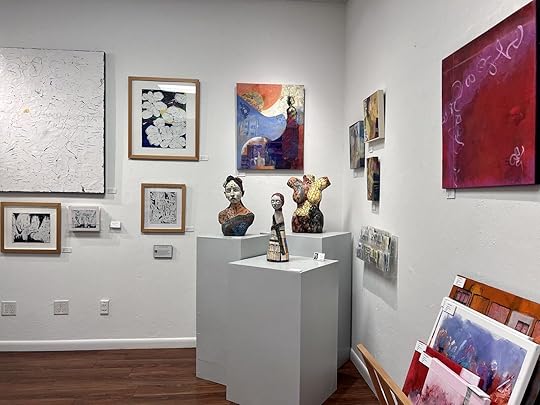
Photo: Jen Ruiz
An unexpected dose of culture awaits inside The Hub on Canal, a co-op of 65 artists that create, display, and sell their work on-site in a building that was once a silent movie theater. Works include everything from watercolors to handcrafted shoes and prices run the gambit. They have a number of community outreach efforts like music nights, art lessons for patients with Alzheimer’s disease, and guitar therapy for veterans with PTSD. Visitors can also drop in for lessons on everything from language classes to music and watercolor lessons, and the venue often hosts live music and stand-up comedy nights, among other fun entertainment options.
3. Browse some funky downtown stores
Photo: Jen Ruiz
While on Canal Street, take some time to peruse rows of chic, locally-owned shops, even if you’re not regularly a shopper. The Galley is a gourmet food store with uniquely flavored olive oils and vinegar on tap infused with ingredients like ginger or pomegranate. The Posh Pineapple is a boutique featuring souvenirs, gifts, and home goods and is great for gifts for people at home. Bikini Company is a swimsuit store that sells tops and bottoms in different sizes, so it’s easy to find something that fits. And for lunch or dinner, head to CorkScrew Bar and Grille – the mojito scallops are a guaranteed crowd-pleaser. Be aware that visiting CorkScrew for happy hour is one of the best things to do in New Smyrna Beach, so it can get pretty crowded on weekends.
4.Visit the New Smyrna Museum of History
Photo: Jen Ruiz
The New Smyrna Museum of History is small but impactful. It exhibits centuries-old navigational maps, a collection of Norman Rockwell posters, and lots of rare coins. And it’s impeccably curated, packing a tremendous amount of information into a relatively small space. During your visit, take the time to speak with a volunteer, all of whom are knowledgeable on everything from archeology to surfing. The museum is across the street from the Old Fort Park Archeological site, celebrating the remains of what may have been the ruins of an early home — or not. No one really knows for sure. It’s free and open to the public.
5. Hike near the Sugar Mill Ruins
Photo: Jen Ruiz
Though it was destroyed before ever becoming operational, the old sugar mill is still happening. The Sugar Mill Ruins date to the 19th century and are currently a lovely (and photogenic) spot for a picnic and quick hike. The ruins stand largely undisturbed, with informative placards and QR codes positioned throughout for guests to learn about what they’re seeing. Visitors can stick to the perimeter of the ruins or venture out into the surrounding nature trails. The turnoff is easy to miss, so make sure you’re using a map or paying close attention on the drive. It’s a fascinating piece of history tucked into the Florida wilderness.
6. Tour the Sugar Works Distillery
Photo: Jen Ruiz
The Sugar Works Distillery should be on every libation-lover’s list. The creative mixologists and pros use fresh herbs and fruits from the distillery’s garden to craft unique cocktails, all impeccably mixed and ornately garnished. Their offerings change seasonally, but they usually have a few rums, a whiskey, and even moonshine, all made without artificial colors, flavors, or chemical sweetening. Visitors can tour the distillery while sipping on custom creations, and the resident mixologist is always open to trying a new recipe.
7. Kayak with the Marine Discovery Center
Photo: Sara Matulonis/Shutterstock
The Marine Discovery Center is a multi-purpose facility with a lot to offer guests interested in marine life. It has a range of educational programs about the Indian River Lagoon. It’s the most biodiverse estuary in North America, with more than 4,000 species of plants and animals. Taking one of the two-hour guided kayaking tours of the lagoon is one of the most popular things to do in New Smyrna Beach, though the tours on a 40-person pontoon boat are pretty fun, too. The center also has specialty tours, like a full moon tour or lighthouse cruise. Expect to see dolphins, shorebirds, and leaping fish on your trip.
The best places to visit in Pakistan for every type of traveler

Despite being blessed with jaw-dropping scenery and well-preserved historical sites, Pakistan has long been written off as a travel destination by all but the most hard-core adventurers. But as the country’s security situation has stabilized in recent years, its domestic tourism industry has come back stronger than ever, and statistics show that foreign tourism is following suit.
Here, snow-capped peaks tower above remnants of some of the world’s first civilizations. Pakistan is home to a unique brand of hospitality that you won’t find anywhere else in the world. And unlike its highly-trafficked neighbors to the east and north, you can spend weeks in the country without encountering another traveler. Combine this with locals who are genuinely happy to see and welcome travelers, and you’ll come to understand why this South Asian nation is truly one of the final frontiers of immersive adventure travel.
In a few months, you can definitely see a very good chunk of Pakistan, and experience a whole lot, too. But for those limited on time, or who really want to come across a specific aspect of Pakistani culture, you’re going to want to make sure your itinerary is focused on just the right spots. These are the best places to visit in Pakistan for every type of traveler, along with a bit of Pakistan travel advice to take with you.
How to get a visa to visit Pakistan
Photo: Punnawit Suwattananun /Shutterstock
Pakistan’s e-Visa system, which was introduced in 2019, makes getting a visa to Pakistan a quick and relatively easy process. Americans and many other nationalities have the option of either getting a traditional tourist visa, or what’s called a “Visa in your inbox.”
The latter requires you to submit a request for travel 24 to 72 hours before your flight, where you’ll also need to include your hotel booking or a Letter of Invitation from a tour company or a personal friend. Approval can take anywhere from moments to a full day, but once it does you’re free to head out, and you’ll be granted a 30-day stay once you arrive in Pakistan.
For longer trips, it’s best to apply for a regular tourist visa. Currently, the best visa one can obtain is a one-year, multiple-entry visa good for 90-day maximum stays, for $90. This visa allows you to leave and enter Pakistan an unlimited amount of times within a one-year period. The duration means that you can stay in the country for 90 days each time before needing to either apply for an extension or leave.
Though it is said to be officially substituted by a confirmed hotel booking, most travelers to Pakistan report the best visa results using a Letter of Invitation written by a registered tour company. This is especially true if you’re requesting a multi-entry visa. Keep in mind that you do not need to actually be on a tour to receive a letter.
Pakistan visa extensionsUnbeknownst to most, Pakistan is an underrated long-term travel/digital nomad destination, as it allows travelers to extend their visas many times. Like your initial visa, extensions are also done online and cost $20 regardless of your nationality or desired duration. This allows you to request a specific duration of extension of up to six months or, in some cases, longer.
While you might be able to get away without including one, it’s best to attach an Extension-specific letter, which can be acquired from a registered tour operator. Keep in mind that the online visa system is not without its difficulties. Travelers often report not getting the duration they asked for, even with all supporting documents. This is frustrating, but on the bright side, extensions are quite cheap.
I recommend Adventure Planners Pakistan. I have used them numerous times for Extension-specific letters. They’re established, and provide client-specific LOIs in less than 24 hours of payment.
Travel to Pakistan from the USA
Photo: Ahminem/Shutterstock
If you’re wondering whether or not Americans can travel to Pakistan, the answer is an emphatic “yes.” Unlike Iran, which requires US citizens to be on a fully-guided tour, American travelers can freely and independently enjoy all that Pakistan has to offer.
Despite what you may have heard from the media, Pakistanis DO NOT hate Americans. Certain people may dislike the American government, but that’s not directed at citizens, and it’s highly unlikely you’ll encounter any animosity at all. I have lived in Pakistan for several years now and have witnessed American travelers of all ages experience the same hospitality and kindness that nationals of any other country receive.
Moreover, it’s important to note that hundreds of thousands of Pakistanis and people of Pakistani descent live in America, and the two countries are official allies, thus making it very easy to travel to Pakistan from the US. The best airlines to fly from the US to Pakistan include Emirates, Etihad Airways, and Turkish Airlines.
American citizens who possess a valid Indian or Chinese visa can also – in non-Covid times – enter Pakistan by land via the Wagah and Khunjerab borders, respectively. Whether you choose to enter Pakistan on foot or by air, the entry process is extremely easy and no different than entering any other country.
The best place in Pakistan for families: Islamabad
Photo: Umer Arif/Shutterstock
As Pakistan’s capital and cleanest city, Islamabad is the perfect place to visit in Pakistan for families. The green capital, which was established in 1967, is the most modern city in Pakistan and makes for an easy start to any trip.
While typically considered sterile by adventure travelers, for families (especially those with kids) Islamabad is ideal. It’s surrounded by the towering Margalla Hills and sits in the moorland of the famous Himalayas. Margalla has numerous hiking trails for all ability levels, and the city itself is graced with numerous parks perfect for play or relaxation. Uber and the local transport apps, such as Careem and InDriver, are also available on-demand, making getting around the city hassle-free.
Islamabad is home to its fair share of must-visit sites, including the Faisal Mosque, which is famous for its unique design and impressive size. Families can also enjoy the Daman e Koh viewpoint which offers sweeping views of the capital as well as entertainment and food.
For families with older kids looking to delve a bit deeper into Pakistan’s culture and history, a day trip to “sister city” Rawalpindi, which is only a 40-minute drive, will surely satisfy those cravings.
We hope you love the Pakistan accommodations we recommend! Just so you know, Matador may collect a small commission from the links on this page if you decide to book a stay. Listed prices are accurate as of the time of publication. See our full Advertiser Disclosure here.
Recommended accommodations in IslamabadBudget option: Jasmine Inn (from $34 per night)
Mid-range option: Serai Boutique Hotel (from $71 per night)
Luxury option: Islamabad Serena Hotel (from $235 per night)

Photo: Jrs Jahangeer /Shutterstock
Solo female travel in Pakistan might sound daunting at first, but a stay in the dreamscape that is Phander Valley will make it seem easy. The peaceful village in the north of the country is one of the safest places in Pakistan, and the locals are just as fantastic as the views.
Unlike other regions of Gilgit Baltistan, Phander has yet to fall prey to mass tourism, which means you’ll likely have turquoise-blue lakes, fields of fluffy cows, and many a viewpoint practically all to yourself.
Locals in Phander are both welcoming and extremely tolerant. While you should still employ typical solo-female-safety tips, it’s a place in Pakistan where people return wallets filled with cash and go well out of their way to help travelers.
You can either camp at the stunning lake of the same name, or opt for one of the many budget-friendly guesthouses along the road. The slow pace of Phander is what makes it so appealing, and while the place remains largely unheard of in western circles, it’s not uncommon to meet other adventurous travelers who are also looking to see what the “Land of Lakes” – a common term for the region that encapsulates Phander – is all about.
Phander is remote and simple and does not yet have a presence on any booking sites, but I highly recommend travelers stay at Lake Inn, which costs about $12 per night and is clean, comfortable, and has a helpful owner.
For information on how to move about Pakistan and reach villages and destinations beyond the major cities, see Matador’s guide on what to know before visiting Pakistan.
The best place in Pakistan for foodies and history buffs: Lahore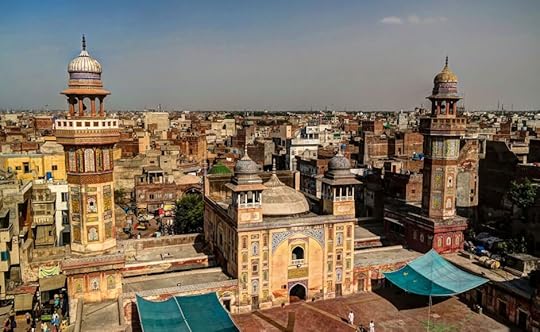
Photo: Homo Cosmicos/Shutterstock
“Lahore Lahore Hai” translates to “Lahore is Lahore” in Urdu, and essentially means that there is no place quite like the bonafide cultural capital of Pakistan. In regards to this South Asian country, truer words have never been spoken from a foodie or history perspective. You can’t quite find a gastronomic culture quite as vibrant, cheap, and accessible as Lahore’s. And encountering historical sites as well preserved as Lahore’s might prove even more of a challenge.
The artsy city was a stronghold of the Mughal Empire from 1524 to 1752, and what remains is in exceptional condition. Lahore’s Wazir Khan Mosque, Jahangir’s Tomb, and the Sheesh Mahal inside of the Lahore Fort all stand out as top historical places not just in Lahore, but in the entire country. The Wazir Khan mosque, in particular, features exquisite frescoes originally painted in the 1600s.
From shrines to forts, Lahore has all you can want from a historical perspective. But its food scene isn’t far behind. From adventurous eats like paya (hoof stew – trust that it tastes a whole lot better than it sounds) to Pakistani favorites like chicken karahi and halwa puri, you can find anything in Lahore at virtually any time. The best places to try these dishes are at street corner stalls – keep an eye out for busy stalls that are bustling with locals.
The city is also one for variety and cheap prices. It’s a place where you’ll discover street food haunts that have been out and about since the 60s interwoven with upscale Western-style restaurants. While other cities can certainly hold their own in regards to Pakistani cuisine and history – looking at you here Karachi and Peshawar – what can be found in Lahore is a combination that is unique to the city’s history of multiple conquests and liberations.
Recommended accommodations in LahoreBudget option: Rose Palace Hotel, Gulberg (from $28 per night)
Mid Range: Luxus Grand (from $56 per night)
Luxury: Pearl Continental (from $120 per night)

Photo: Daniela Collins/Shutterstock
Pakistan’s innumerable peaks and glaciers are the best-kept secrets of the alpine world, and they comprise enough trails and summits to keep even the most diehard trekkers busy for years. The country is home to not one but three of the world’s greatest mountain ranges: the Karakorams, Himalayas, and the lesser-known Hindu Kush.
While there are intensely beautiful and nearly empty trails to be found all over regions of Gilgit-Baltistan and Chitral, for the absolute best hikes in Pakistan, head to Skardu. The mountain city is the perfect place to arrange and embark on a wide variety of seriously epic adventures.
For a tough but worthwhile day hike, aim for Masur Rock, a viewpoint that gives exceptional views of Skardu City and beyond. For mid-level hikers, a two-to-three-day expedition to the flawless Laila Peak Basecamp should be at the top of your list. Companies including Chogori Adventure offer guided treks that start at $1,100 per person. This includes lodging before and after the trek, airport transfer, and most meals.
These two can easily be arranged on your own, but the real heavy-hitters are the treks that lie in the awe-inspiring Central Karakoram National Park, a restricted area for foreigners. To visit, you’re going to need some permits, and most likely a registered guide, too. Fees include a “peak fee,” which varies depending on the trek, a trekking permit that costs $50 per person, and an expedition permit that costs $200 per expedition. These fees do not include any charges set forth by the guide. Apply for the permits, identify and research guides, and pay fees via the park’s website.
Famous treks that require such pre-planning include K2 Basecamp, which allows you to get up close and personal with the world’s second tallest mountain, and Snow Lake, a trek that will give you the opportunity to cross the massive Biafo Glacier and camp atop a glacial basin underneath millions of stars. You’ll also want to hit Trango Towers, a collection of giant rock monoliths in Gilgit-Baltistan.
Recommended accommodations in SkarduBudget: Hotel Dewanekhas (from $21 per night
Mid-range: Mountain Lodge Skardu (from $49 per night)
Luxury: Serena Shigar Fort (from $150 per night)
You might have heard that Pakistan has some pretty cool mountains, but what about beaches? The country also has hundreds of miles of coastline, which is best enjoyed in and around Karachi.
As Pakistan’s largest city and financial capital, Karachi is lively, to say the least. But what makes it the perfect place in Pakistan for a day in the sand is the fact that it’s teeming with stunning swaths of coastline. Most well-known is Clifton Beach, which most closely resembles a carnival scene complete with scores of camels, go-karts, and shiny horses, all available for riding.
While Clifton isn’t the cleanest place in the world to swim, fear not, as lots of swimming-friendly seashores exist within two hours of the city center. French Beach is a particularly posh locale filled with trendy huts to relax in and “be seen,” and some of the cleanest seawater in Karachi. This beach is particularly progressive, and even bikinis are acceptable – a rarity in the country.
A few minutes from French Beach, you can catch some other clean and swimmable beaches like Hawkesbay, Turtle, and Sandspit beaches.
The real highlight of Karachi’s beach scene takes a bit more effort to reach, but comes with a huge reward. Deep in the dry, rural countryside two hours from the city is a completely uncommercialized fishing village, and the acclaimed Mubarek. Here, soft golden sand and bright blue water are sandwiched in between arid hills that will make you feel like you’re across the Arabian Sea in Oman.
Unfortunately, public transit doesn’t exist here, which though frustrating, also protects the area from over-tourism. Recently, apps like EzHire have joined the market for moderate daily rates, meaning that you can enjoy this must-see Karachi beach at your own convenience. If you make it there, be sure you hike up to the viewpoint all the way on the left, where you can also visit a local mazar (shrine.)
Recommended accommodations in KarachiBudget: KTown Rooms (from $20 per night)
Mid-range: Hotel Cozy Beach Vista (from $36 per night)
Luxury: Pearl Continental (from $110 per night)

Photo: naihei/Shutterstock
Hunza Valley is undoubtedly one of the most beautiful places in Pakistan and also one of the easiest places to travel in, too. Whether you’re a young family, a retiree, or a mountaineer looking to bag a peak, Hunza Valley in northern Pakistan absolutely has something for you.
The culture of the valley is unlike anywhere else in Pakistan, and the people of the central part of the valley even speak a language so isolated that’s been unable to be tied to any others. Situated along the wondrous Karakoram Highway, a visit to Hunza means getting to know a unique culture, savoring organic fruits, getting up close with jaw-dropping scenery, and so much more depending upon your interests.
Aside from its natural beauty, the region also has the highest literacy rate in the entire country and is known for its welcoming and tolerant local people. Even alcohol is widely brewed and consumed by locals. And while you’ll still want to avoid shorts, the general dress code is much more relaxed in Hunza.
Unless you travel by plane, reaching this Pakistani paradise does take a bit of dedication. But for as little as $12 and about 24 hours, you’ll leave the chaos of the cities behind and find yourself in a stadium of the country’s most beautiful mountains. From Skardu or Gilgit, you can take a taxi (see Rome2Rio). If coming from one of the major cities in Pakistan, you will likely need to fly into either Skardu or Gilgit.
Recommended accommodations in Hunza ValleyBudget: Old Hunza Inn (from $25 per night)
Mid Range: Mountain Story (from $68 per night)
Luxury: Luxus Hunza (from $206 per night)

Photo: thsulemani /Shutterstock
For the typical traveler who wants to experience the very best of the country on the quick, here are some of the coolest things to do in Pakistan:
Spend time in a local home: Pakistanis are some of the friendliest people you’ll ever encounter, and it won’t be long before you’re receiving invitations for chai, accommodation, and more. While it might seem strange to hang out with a random stranger, know that these are the experiences that make Pakistan so much more than just a place with epic mountains. Welcoming guests is deeply ingrained in local culture, so know these invitations are genuine and the best way to get to know real Pakistanis.Hike to Fairy Meadows in Gilgit-Baltistan: The most popular hike in the country has truly earned its top spot. The lush meadow, which can only be reached by a combination of a perilous jeep ride followed by a two-to-three-hour trek, gives unparalleled views of Nanga Parbat, which is the world’s ninth highest peak, and dubbed the “Killer Mountain.” If you’re into trekking, you can even keep going to the mountain’s basecamp with a tour operator such as Apricot Tours.Try dumba karahi: If you’re looking for a culinary experience that you’ll remember forever, look no further than what just might be Pakistan’s most delicious dish, dumba karahi. Dumba is a specialty of the Khyber Pakhtunkhwa province and consists of the extremely tender – and very delicious – tail meat of a dumba sheep, a species known for their large behinds. Unlike many dishes in Pakistan, which tend to be too spicy for foreign tastebuds, dumba is traditionally made in a style of cooking that forgoes chilies. The most authentic dumba karahi can be found in and around Peshawar, though all major cities have restaurants that serve it.Celebrate a local festival: Pakistanis sure know how to party, and few events can provide more cultural immersion than attending and taking part in a big holiday. There are dozens upon dozens of them throughout the year, but the easiest ones to participate in are Eid ul Azha ( a three-day celebration of sacrifice taking place in July) and Eid Milad un Nabi (the birthday of Prophet Muhammad in October). Both are celebrated with fervor and welcome all comers in the old sections of major cities like Lahore and Rawalpindi.
Bookend your Bay Area trip at one of these gorgeous San Francisco airport hotels

San Francisco International Airport (SFO) is located south of the city center in San Bruno. Abutting the San Francisco Bay to the west, SFO offers one of the most beautiful takeoff and landing experiences of any major US airport, with water on both sides as you descend or depart. These are the top hotels near San Francisco airport.
We hope you love the San Francisco airport hotels we recommend! Just so you know, Matador may collect a small commission from the links on this page if you decide to book a stay. Listed prices are accurate as of the time of publication. See our full Advertiser Disclosure here.
Headliner San Francisco airport hotelsTop Marriott Bonvoy San Francisco airport hotelsTop World of Hyatt San Francisco airport hotelsTop Wyndham Rewards San Francisco airport hotelsHeadliner San Francisco airport hotelsGrand Hyatt at SFO
Photo: Booking.com

Photo: Booking.com

Photo: Booking.com

Photo: Booking.com
Located adjacent to the airport’s main entrance, the Grand Hyatt at SFO is a quick walk from all terminals. Bookending a trip to San Francisco is super easy and convenient here, with an onsite bar and fitness center (in case the airport yoga room wasn’t enough), and gorgeous rooms overlooking the airport property. Watching planes take off and land is a surprisingly soothing way to fall asleep. Moreso when you know that all you have to do to get to your flight in the morning is take the elevator downstairs to hit security.
The hotel’s restaurant serves food late and can arrange for early-morning breakfast to be delivered to your room. At concierge, 24-hour desk service can connect you with services either at the airport or in San Francisco itself, which is a 15-to-20-minute Uber ride or under 30 minutes on the BART train. Plus, milk (or use) those World of Hyatt rewards points here.
Airport shuttle: N/A24-hour front desk: YesFitness center: YesPrice: From $259 per night
The Dylan Hotel
Photo: Booking.com

Photo: Booking.com

Photo: Booking.com

Photo: Booking.com
Boutique hotels that are actually boutique are a rarity these days. Boutique airport hotels are even rarer. The Dylan Hotel San Francisco Airport is both, and it does an incredible job of providing a unique and memorable hotel stay just over one mile from the airport. The experience is truly San Franciscan – modern and with luxe amenities and WiFi, and also within five minutes’ walk of a plethora of delicious restaurants. And, the BART picks up just up the street, or an Uber to the terminal is quick and painless. The hotel features a bar, a coworking station, and plenty of character – and don’t miss the afternoon happy hour in the lobby.
Airport shuttle: Yes24-hour front desk: YesFitness center: NoPrice: From $109 per night
Hotel 1550 San Francisco Airport
Photo: Booking.com

Photo: Booking.com
Booking.com noted Hotel 1550 a certified Travel Sustainable property, ensuring that you’ll be causing minimal environmental impact here when compared to other hotels in the area. That’s because the hotel has passed the site’s “independently validated model of sustainability criteria that takes into account geographic specifics related to the accessibility & cost to implement certain practices.” On top of its sustainability efforts, the hotel is quite comfortable and efficient, with a minimalist aesthetic, good WiFi, and a hearty continental breakfast.
Airport shuttle: Yes24-hour front desk: YesFitness center: YesPrice: From $104 per night
Top Marriott Bonvoy San Francisco airport hotelsAloft San Francisco Airport
Photo: Booking.com

Photo: Booking.com
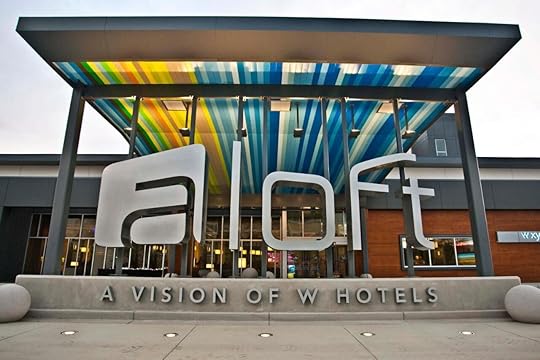
Photo: Booking.com

Photo: Booking.com
Aloft is a Marriott-backed boutique that adds a colorful, clean airport hotel experience just adjacent from SFO. Here at Aloft SFO, everything from the pool to the tricked-out lobby to the catchy art in the rooms is part of the experience. Guests love sitting over a drink on the patio or shooting a game of pool in the lounge. In-room, beds are super comfy and swap that useless box spring for a thick mattress on platform. The place is helplessly hip, and if any San Francisco airport hotels speak to the contemporary age of bleisure travel and remote work, it’s this one.
Airport shuttle: Yes24-hour front desk: YesFitness center: YesPrice: From $93 per night
Westin San Francisco Airport
Photo: Booking.com

Photo: Booking.com

Photo: Booking.com
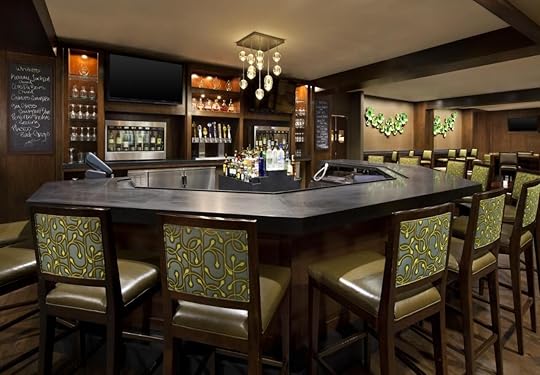
Photo: Booking.com
Westin is an iconic brand known for its upscale wellness focus, of particular relevance in a progressive city like San Francisco. The Westin San Francisco Airport is about a mile from both the airport itself and the airport BART station. Rooms feature Westin’s Heavenly Beds and offer picturesque views of the south Bay Area and of the San Francisco Bay. The real perk of staying here, though, is the onsite Grill & Vine restaurant, which serves well-heeled fare and nice cocktails reminiscent of San Francisco’s urban core moreso than an airport hotel village.
Airport shuttle: Yes24-hour front desk: YesFitness center: YesPrice: From $118 per night
Top World of Hyatt San Francisco airport hotelsHyatt Regency San Francisco Airport
Traveling to the Bay Area? Check out Matador’s guides to where to stay in northern California:
The 9 best San Francisco Airbnbs with views of the skyline and Golden Gate The most unique weekend getaways near San Francisco you can rent on Airbnb 10 luxurious Airbnbs for your Napa Valley bachelorette party

Photo: Booking.com

Photo: Booking.com
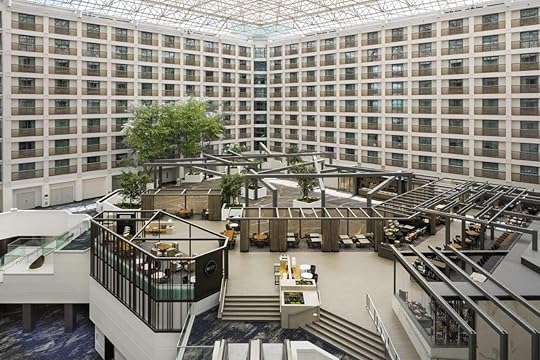
Photo: Booking.com
Hyatt Regency San Francisco Airport offers a level of sophistication few other San Francisco airport hotels do. Its 3SIXTY Bar and Bistro serves refined American cuisine for breakfast lunch and dinner, and can arrange room service for those departing early or arriving late. It’s fitness center overlooks the pool. And its bright, spacious entryway and lobby is akin to entering a luxury shopping mall, complete with top-tier service and a comfortable lounge.
Airport shuttle: Yes24-hour front desk: YesFitness center: YesPrice: From $139 per night
Top Wyndham Rewards San Francisco airport hotelsRamada Limited and Suites San Francisco Airport
Photo: Booking.com

Photo: Booking.com
Ramada Limited and Suites San Francisco Airport occupies a unique place in the lexicon of airport hotels. It’s as though the brand was built for this – efficient dining and room service for travelers in and out quickly is a standard. As is rapid WiFi. And a clean, comfortable in-room experience that is familiar enough to feel approachable, but refined enough to make you feel a little better about that 6:30 am flight in the morning. The Ramada San Francisco airport hotel is 1.5 miles from SFO and only slightly further from the South San Francisco Convention Center.
Airport shuttle: Yes24-hour front desk: YesFitness center: YesPrice: From $100 per night
La Quinta by Wyndham San Francisco Airport West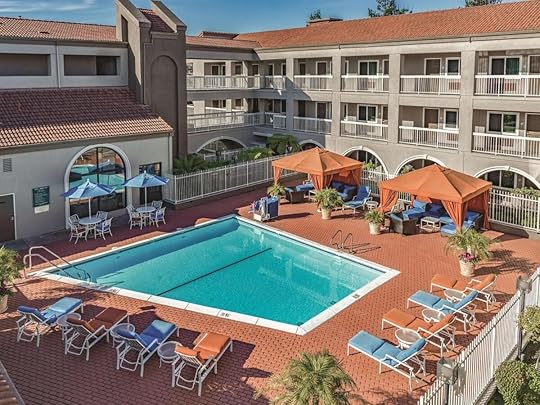
Photo: Booking.com

Photo: Booking.com
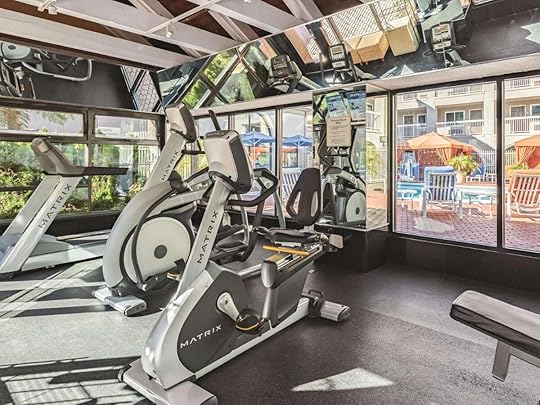
Photo: Booking.com
The “west” in the La Quinta San Francisco Airport West’s name is both ironic and fortunate at the same time. If it were east of the airport, you’d be sleeping in the San Francisco Bay. It’s also convenient as the airport terminal exits towards the hotel, just a quick shuttle ride from baggage claim. Onsite, take advantage of the hotel’s expansive outdoor pool and lounge area, an ideal place to relax while preparing for – or after – a long day of travel. This pet-friendly hotel has free WiFi and a strong continental breakfast (the type where you’ll have to resist pocketing a few items to take with you through security). Rooms are cozy and while standard, are clean and quiet. 
Price: From $104 per night
More like thisWhere to StayBookend your Atlanta trip with a stay at one of the top hotels near Hartsfield-Jackson Atlanta International Airport6 new train routes that will help you see the world by rail in 2022

While “it’s not the destination, but the journey” may be a bit of a cliche, train travel is one way this platitude rings true. This year brings more exciting ways for us to dive into train travel in the US, Europe, Asia, and Africa. In 2022, the US will receive its first high-speed bullet trains, while the expansion of luxury sleeper train routes in Europe will connect countries like The Netherlands to Switzerland while offering a good night’s sleep. Train travel offers more than stunning scenic views, it’s also a more sustainable way to travel; electric trains can be up to 80 percent better for the environment than flying by cutting down on emissions. So this year, when determining how you’d like to travel, here are some great new train routes that lead to some amazing destinations.
United States1. Boston to Washington DC
Photo: Amtrak
The Amtrak Northeastern corridor trains are getting an upgrade after over 20 years in service. The new Acela trains will travel from Boston through Providence, New Haven, New York City, Philadelphia, Wilmington, Baltimore, and Washington, DC. With Asia and Europe investing in high-speed rail since the 1960s and 70s, 2022 is the year the US will catch up with trains that reach up to 160mph.

Photo: Amtrak
Built with the COVID-19 pandemic in mind, expect oversized bathrooms, touchless technology, and comfortable seats with U-shaped headrests that create space between passengers. You can also pre-book and choose your row. Once you’re settled in, enjoy the complimentary WiFi and built-in USB and plug-in outlets to keep your devices powered up.
Europe2. Belgium to Prague
Photo: European Sleeper
Sleeper trains are a perfect choice when country hopping in Europe. European Sleeper, a Netherlands-based operator, and Czech operator Regio Jet have teamed up to connect major cities like Brussel, Amsterdam, Berlin, and Praha. When you’re awake, you can take advantage of the complimentary WiFi, breakfast, and free coffee. And if you’d like to add a stop in the UK, an easy switch to the Eurostar service will take you there. Tickets will go on sale in April for travel beginning summer 2022, with trains running every other day.
3. Paris to Vienna
Photo: NightJet
This ride from France to Austria offers great views right before bed and breakfast in the morning. This journey heads through the Marne Valley and offers an enjoyable sunset over Champagne vineyards. You’ll find peaceful rest in one of the three NightJet options for sleep. For just 29 euros ($33), you can relax in plush seating, splurge for 50 euros ($57) for your group of four to six in a couchette, or book a single, double, or triple starting at 89 euros ($101).
4. Amsterdam to Zürich
Photo: NightJet
NightJet also connects you from The Netherlands to Switzerland on a 12-hour ride using the Rhine Valley route with the same comfortable options as the trip from Paris to Vienna starting at 59 euros ($67). Using Eurostar, travelers in London can travel to Amsterdam in less than four hours, and then take this train at night and reach Zurich by morning.
Asia5. Thailand to Laos
Photo: Pratan Saetang/Shutterstock
For just $23, you can travel from Bangkok, Thailand, to Vientiane, Laos, and Boten, which borders China via day or sleeper train. The Chinese-government-funded project makes it much easier to travel in Asia, especially from the landlocked country of Laos. What was once a 15-hour trip from Laos to the Chinese border can now be done in just four hours. Passengers can expect multi-lingual train attendants, luggage alarms connected via Bluetooth, and delicious snacks on board. Asia is to become even more accessible by train over the coming years, with planned connections through Laos, Myanmar, Thailand, Vietnam, Cambodia, and Malaysia. Service for this new train began in December 2021. Tickets aren’t available directly online.
Africa6. The Copper Trail
Photo: Rovos Rail
If you’re looking for an all-inclusive journey through Africa, in July 2022, Rovos Rail will launch its latest route, The Copper Trail. The journey is a 15-day 1927 mile journey through Zimbabwe, Zambia, the Democratic Republic of Congo (DRC), and Angola. This all-inclusive trip includes excursions like a visit to an elephant sanctuary in Zambia, a copper mine visit in the DRC and a sunset river cruise to Victoria Falls. The Rovos suites — on what is considered one of the most luxurious train lines in the world — start at $13,200. The price includes private bathrooms, modern amenities, all meals and beverages onboard, and beds that fold up into sofas to soak up the journey during the day. 
February 2, 2022
Stay in Issa Rae’s new Airbnb listing in the heart of South LA — home of ‘Insecure’

Issa Rae and Airbnb are offering the stay that dreams are made of for the committed Insecure fan who loves Super Bowl Sunday. For just $56 a night, one lucky guest and a friend will get the chance to stay in an Issa Rae-hosted Airbnb from February 12 through 14. Guest will have the chance to enjoy the iconic landmarks popularized by the show, along with the Black culture, businesses, and communities that make South LA so special.
First, get checked in virtually by the one and only Issa Rae. Next, take in the property — a stylish mid-century View Park pad decorated with artwork by local Black artists including Maya Iman, Vakseen, and Domonique Brown. The home also boasts panoramic views of Los Angeles and the Hollywood Hills from the outdoor lounge and a pool dripping in Issa vibes with chaise lounges and canopies. Then, find the curated guidebook filled with Issa’s favorite local spots, including the Black-owned bookstore Eso Won Books, My 2 Cents, Supervsn Studios, Gorilla Rx Wellness, Swift Cafe, ALL CHILL, and Southern Girl Desserts — and if that isn’t enough suggestions, try any of these Black-owned restaurants in LA. After a day spent soaking up all there is to offer, return to the house to “wine down.” On Sunday, enjoy the Sienna Naturals hair care line for some self-care and get ready for your “Game Day” dinner for two, courtesy of Worldwide Tacos, featured in the iconic season three episode.

Photo: Sean Costello
Airbnb has also put together a $500,000 donation with Nasdaq. The money will help local organizations with visions in line with Nasdaq’s ambitions to advance inclusive growth and prosperity and to empower under-represented communities in their efforts to generate wealth like LeadersUp, Central Neighborhood Health Foundation, and Brotherhood Crusade. The company also plans a first-time LA expansion of The Airbnb Entrepreneurship Academy and is collaborating with the non-profit Nasdaq Entrepreneurial Center to offer an educational module focused on entrepreneurship and “solopreneurship” to Airbnb Academy participants.
“Since my series debuted in 2016, it’s been an honor to showcase the people, culture and businesses that make South LA such a vibrant part of the city,” Rae said in a statement. “I became an Airbnb Host to create a stay where fans of the show can experience this for themselves. From dinner by Worldwide Tacos on game day to art from my favorite local artists on the walls — this is LA, my way.”

Photo: Sean Costello
Guest should note they’re expected to strictly follow Los Angeles County’s COVID-19 guidelines. Booking begins Tuesday, February 8 at 10 AM PST. 
Puerto Ricans are protesting the attempted privatization of their public beaches

One of the best things about Puerto Rico is its natural beauty. In particular, the many amazing beaches across its islands — all of which are public. Though there are no private beaches in Puerto Rico, some beachgoers and newcomers apparently thought otherwise. On January 26, 2022, an incident was posted on social media that showed a couple who had purchased one of the multi-million-dollar homes on Ocean Park beach trying to block off a section for themselves. When questioned by the beachgoers, the unidentified woman in the video insulted them.
“Buy a million-dollar house, then you can give your opinion here,” the woman told Lydibett Santiago in Spanish.
@latinorebelstiktok Protest against privatization of beaches in #PuertoRico #news #lol #wow #latino #fyi #event #beach #saturday ♬ Tanto – Cassie Marin
So, Wilmar Vázquez decided to organize a protest and rally Puerto Ricans for a “Beach Olympics,” according to the Latino Rebels. The event was a beach block party hosted in front of the couple’s house to showcase that Puerto Rico’s beaches always have and always will be open to the public. The protest attracted hundreds of people who participated in beach tennis tournaments at the dozen-plus tennis courses set up for the event, along with beach volleyball, beach hockey, and air aerobics. Other event-goers came just to take in the sun, watch performances, and enjoy the food and beverages donated by community members.
@latinorebelstiktok Today at the #oceanpark beach protest in #puertorico🇵🇷 ♬ original sound – Latino Rebels
In recent years, some Puerto Ricans have become concerned about the gentrification of Puerto Rico and the new property developments on the beach. A 2009 Puerto Rico Coastal Zone Management Program document provides more details on beach access policies in Puerto Rico. One policy states:
“Development in front of the coast, be they public or private, should, in the measure in which it is practical, be designed to facilitate instead of obstructing access to the coast by the general public. It is recognized that the general wellbeing, on occasions, requires restriction of access (i.e. to areas of environmental crisis or endangered species or for public safety reasons). However, the de facto segregation of public beaches, as a result of development patterns, for the enjoyment of private landowners by preventing access by the general public is prohibited in Puerto Rico.”
These policies have not changed.
@latinorebelstiktok More from #oceanpark protest in #puertorico🇵🇷 ♬ original sound – Latino Rebels
So, it looks like public beaches in Puerto Rico are here to stay, regardless of what the owners of million-plus-dollar beachfront properties say. 
Matador Network's Blog
- Matador Network's profile
- 6 followers



